SOCIOLOGY
Paper – II
Note : This paper contains fifty (50) objective type questions of two (2) marks each. All questions are compulsory.
1. Who has stated that the history of society is the history of the class struggle ?
(1) Emile Durkheim
(2) George Herbert Mead
(3) Erving Goffmann
(4) Karl Marx
2. Who has propounded the concept of ‘collective representation’ in sociology ?
(1) Emile Durkheim
(2) Max Weber
(3) Auguste Comte
(4) Karl Marx
3. A Society which pessimistically depicts the social transformation brought about by modernization is a :
(1) Global society
(2) Local society
(3) Mass society
(4) Civil society
4. In any social arrangement in which the behaviour of majority is governed by norms and roles is known as :
(1) Association
(2) Community
(3) Institution
(4) Culture
5. Lack of appropriate cultural resources like language and knowledge is known as :
(1) Cultural materialism
(2) Cultural deprivation
(3) Cultural trait
(4) Cultural pluralism
6. Who has said that “man’s uniqueness lies in his possession of culture” ?
(1) R.M. MacIver
(2) E. Durkheim
(3) R. Benedict
(4) K. Davis
7. Which one of the following is not an ascribed status ?
(1) Sex
(2) Age
(3) Occupation
(4) Kinship
8. Which one of the following refers to an individual whose behaviour in a particular role provides a pattern upon which another individual bases his behaviour in performing the same role ?
(1) Ideal role
(2) Role model
(3) Perceived role
(4) Internalized role
9. Match List-I with List-II and select the correct answer from the codes given below the lists.


10. Who has observed that ‘each person in society inevitably occupies multiple statuses and that, for each of these statuses, there is an associated role’ ?
(1) R.K. Merton
(2) R. Linton
(3) T. Newcomb
(4) W.F. Ogburn
11. The distinction between in-group and out-group was given by :
(1) G. Simmel
(2) P. Sorokin
(3) W.G. Sumner
(4) H. Spencer
12. Who has classified groups into ‘dyad’ and ‘triad’ ?
(1) Sorokin
(2) Sumner
(3) Simmel
(4) Giddings
13. Who has said that marriage is rooted in the family rather than the family is rooted in marriage ?
(1) Kingsley Davis
(2) G.P. Murdock
(3) E. Westermarck
(4) C. Levi-Strauss
14. ‘Taravad’ is a kind of :
(1) a kinship usage
(2) a rule of residence
(3) an extended family
(4) a community
15. Match List-I with List-II and select the correct answer from the codes given below the lists :


17. Match List-I with List-II and select the correct answer from the codes given below the lists :

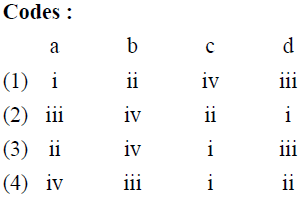
17. Which one is the correct statement about socialization ?
(1) An election process
(2) A time taking process
(3) A policy making process
(4) A role seeking process
18. Which one is the important concept in the theory of Socialization held by Emile Durkheim ?
(1) Role performing
(2) Imagining the other
(3) Collective consciousness
(4) Division of labour
19. Pierre Bourdieu’s theoretical perspective makes use of the concept of capital. Which of the following is not a part of this concept ?
(1) Economic Capital
(2) Political Capital
(3) Social Capital
(4) Cultural Capital
20. Which term is used to describe various aspects of an individual’s identity such as class, ethnicity, gender, disability and location ?
(1) Intersectionality
(2) Ascription
(3) Meritocracy
(4) Mobility
21. Who among the following has conceptualized caste stratification into four types namely cultural universalistic, cultural particularistic, structural universalistic and structural particularistic ?
(1) Andre Beteille
(2) E.R. Leach
(3) Yogendra Singh
(4) A.C. Mayer
22. Match List-I with List-II and select the correct answer from the codes given below the lists :

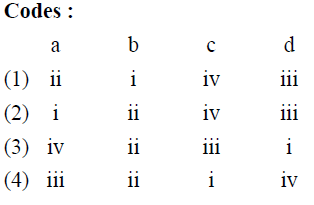
23. Given below are two statements, one is labelled as Assertion (A) and other as Reason (R) :
Assertion (A) : Social change is inevitable.
Reason (R) : There are various kinds of external and internal forces operating with each other within the system.
Select the correct answer from the codes given below :
Codes :
(1) Both (A) and (R) are true and (R) is the correct explanation of (A).
(2) Both (A) and (R) are true, but (R) is not the correct explanation of (A).
(3) (A) is true, but (R) is false.
(4) (A) is false, but (R) is true.
24. Match List-I with List-II and select the correct answer from the codes given below the lists :
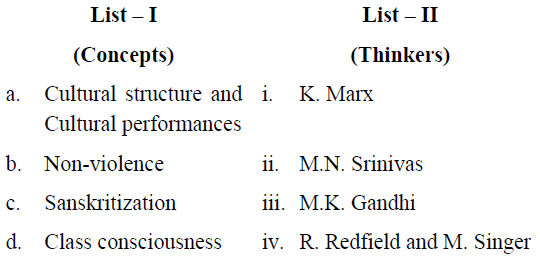

25. According to whom anthropology is a natural science and studies human society, often using the methods of the natural sciences ?
(1) B. Malinowski
(2) A.R. Radcliffe-Brown
(3) C. Levi-Strauss
(4) John Dewey
26. Who talks about ‘roles’ in virtue of social relationships ?
(1) A.R. Radcliffe-Brown
(2) R.K. Merton
(3) S.F. Nadel
(4) C. Levi-Strauss
27. According to whom, culture is held to embody principles which mirror essential features of the human mind – ‘binary classificatory systems’ ?
(1) S.F. Nadel
(2) A.R. Radcliffe-Brown
(3) R.K. Merton
(4) C. Levi-Strauss
28. Match List-I with List-II.

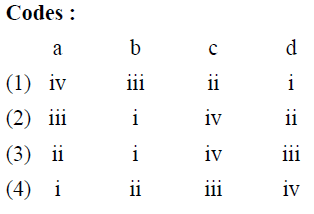
29. Malinowski is best known for emphasizing the importance of which one of the following ?
(1) Oral History
(2) Content Analysis
(3) Ethnography
(4) Narratives
30. Which term is used by Parsons to explain the fundamental ‘dilemmas’ facing all actors and involved in all social situations ?
(1) Social Actions
(2) Value Orientations
(3) Pattern Variables
(4) Functional Pre-requisites
31. Central to Durkheim’s functionalism was a distinction between which forms of social organization ?
(1) Normal and Pathological
(2) Normal and Healthy
(3) Average and Abnormal
(4) Forced and Anomic
32. According to Merton which one of the following sequences is correct ?
(1) Innovation, Retreatism, Ritualism, Rebellion.
(2) Ritualism, Rebellion, Innovation, Retreatism.
(3) Rebellion, Retreatism, Ritualism Innovation.
(4) Innovation, Ritualism, Retreatism, Rebellion.
33. “The problems which scientists selected for study, and their conceptualization, were determined by the values of the scientists.” According to Max Weber, this statement refers to
(1) Value Judgement
(2) Value Neutrality
(3) Normative Value
(4) Value Relevance
34. Match List-I with List-II.
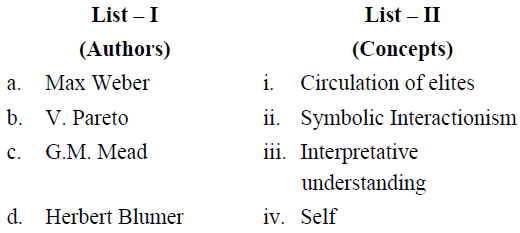
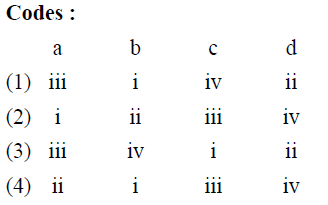
35. According to Marx ‘when people become aware of their conflicting relations with other classes’ then it results into :
(1) Class in itself
(2) Division of labour
(3) Class for itself
(4) Development of leadership
36. Who has stated that ‘the conflict is dysfunctional, if the structures are rigid’ ?
(1) K. Marx
(2) L.A. Coser
(3) E. Durkheim
(4) J.C. Alexander
37. According to Dahrendorf, “the aggregates of incumbents of positions with identical role interests” is known as :
(1) The interest group
(2) The conflict group
(3) The quasi group
(4) The Primary group
38. Who has written the book ‘Rules of Sociological Method’ ?
(1) Max Weber
(2) Auguste Comte
(3) Emile Durkheim
(4) Karl Marx
39. Match List-I with List-II and select the correct answer from the codes given below the lists :
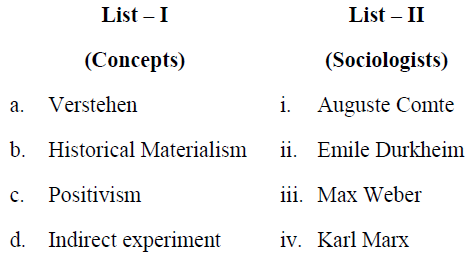
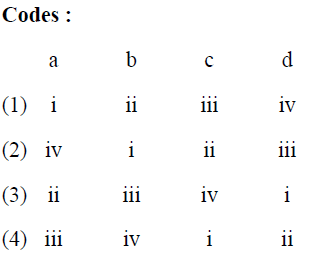
40. Who has presented the view, ‘a historical approach that also makes possible generalizations about processes of social change’ ?
(1) C.H. Carr
(2) Max Weber
(3) Arnold J. Toynbee
(4) Karl Marx
41. A survey design meant for collection of data needed from the same selected population at different points of time is known as :
(1) Cohort Survey
(2) Cross-sectional Survey
(3) Longitudinal Survey
(4) Pilot Survey
42. A hypothesis that suggests no relationship among the variables selected under study is called :
(1) Conflict hypothesis
(2) Comfort hypothesis
(3) Null hypothesis
(4) Contrary hypothesis
43. Who said these words : “I started research as a non-participating observer. As I became accepted into the community, I found myself becoming almost a non-observing participant” ?
(1) B. Malinowski
(2) E. Durkheim
(3) William.F. Whyte
(4) N. Anderson
44. Given below are two statements, one is Assertion (A) and other is the Reason (R) :
Assertion (A) : Qualitative methods are often criticized for failing to meet the same standards of reliability.
Reason (R) : The procedures used to collect data in Qualitative studies are precise and accurate.
Select the correct answer from the codes given below :
Codes :
(1) Both (A) and (R) are true and (R) is the correct explanation of (A).
(2) Both (A) and (R) are true, but (R) is not the correct explanation of (A).
(3) (A) is true, but (R) is false.
(4) (A) is false, but (R) is true.
45. The study of recorded human communications such as books, websites, paintings, Laws is known as
(1) Content analysis
(2) Semiotics
(3) Book-view
(4) Ethnography
46. In which qualitative approach the primary goal is to gain access to individuals’ inner world experiences ?
(1) Case study
(2) Ethnography
(3) Phenomenology
(4) Grounded theory
47. In a normal distribution the Mean, Median and Mode are located at :
(1) All the three in the centre.
(2) Mean on the left of centre, Median in the Centre and Mode on the right of centre.
(3) Mean in the centre, Median on the left, Mode on the right.
(4) None of the three is located in the centre.
48. Which one of the following averages can be applied to the qualitative variables ?
(1) Mean
(2) Mode
(3) Median
(4) Geometric Mean
49. Correlation coefficient measures the relationship between which couple of variables ?
(1) A qualitative and a quantitative variable.
(2) Both the qualitative variable.
(3) Both the quantitative variables.
(4) More than two qualitative variables.
50. Reliability in social research includes :
A. Dependability of data collected.
B. A test or measurement used to collect data.
C. A test of consistency and association.
D. A measure which gives same results if repeated.
Mark the correct answer from the codes given below :
Codes :
(1) A, B and C
(2) B, C and D
(3) A, C and D
(4) A, B and D
Latest Govt Job & Exam Updates: